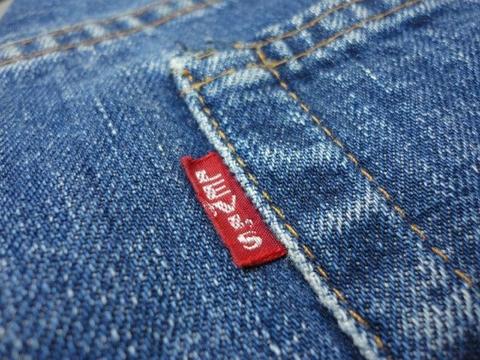A Guide to Levi's Tabs
Men's Levi's Jeans Women's Levi's Jeans
Shop Levi's 501 Shop Levi's 505 Shop Levi's 550
How can you tell your Levis from your Samurai? Why have some Levis got big ‘E’s’ and small ‘e’s?’ Why do some have just the trademark logo and why are some orange? We’re going to take you through a simple guide on what tab colours means what, and how to differentiate even the smallest of differences on Levi’s tabs.
What's with the Red Tab on Levis?

When Levis patent expired in 1890, competitors such as Stronghold, Boss of the Road, Can't Bust ‘Em started manufacturing riveted denim jeans. From a distance the pocket stitching looked similar, they had a patch on the waistband and of course, they were all blue. Frustrated, the national sales manager of Levi’s, Chris Lucier, came up with the idea of a little red tag on the back pocket. With Levi’s sewn in white so whether you were at a rodeo or a movie, you could see immediately who was wearing Levi’s.
The little red label was patented in 1936 and today the tab is one of the most iconic parts of a pair of Levi’s jeans. Today the simple tab has become a part of roofless trade wars with copies of the red tab popping up all over the world, with Canes, Geisha and Samurai jeans to name a few copying the tab. It's so intense that Levi’s hire undercover detectives all over the world to catch the sellers of the counterfeit jeans and to cut the red tags off one by one!
Levi’s Big E.

Levi’s created the ‘Capital E’ tab ran from 1936 when the tab was first introduced as previously mentioned by Chris Lucier and ran until 1971. After 1971 Levi’s changed the tab letters in small ones, Levi’s instead of LEVI’S. For the real denim collectors, it’s a true treasure when you find an original Levi’s Big E item. In the Big E area there were some more different tab colours on the back pocket besides the famous red one; orange, white and black. Levi's Orange Tab was for fashion jeans, White Tab was generally for Levi’s For Gals (except it was also for corduroy). The Black Tab with gold lettering meant the pants had undergone the STA-PREST process (non-iron).
Just to confuse things, Levi's have started using their Big E label in some of their recent Eastern European production. A quick look at the care label inside will alert you to this.
Levi’s Small e.

In 1971 Levis had changed its tab to red Levi’s rather than LEVI’S. However, the only letter to change visibly was the ‘e.’ This has become a mark amongst collectors to differentiate a collectors big E to a more mass produced small e, the latter still in production today.
The Red Tab with the Trademark
You might come across a pair of Levis with just the trademark and write them off as a fake, however, they are intentionally designed with the almost blank tab. Since the tab is copied the world over, it requires extra-legal force from Levi’s and their right to market clothes with the tab. They, therefore, have to produce a certain percentage of Levi’s products with a plain Tab and just the trademark symbol. This shows that Levi’s owns trademark rights in the Tab itself, not just Levi’s wording.
The Orange Tab

Everyone has a favourite and this one is mine! In the 1960s Levis wanted to differentiate other kinds of Levi’s from the standard 501s. It was the birth of their ‘fashion denim’ - Shirts, jeans hats, flares and boot cuts. The design team of Levi's Orange Tab, got to be more experimental, changing the silhouettes and stepping out of the stringent requirements put behind red tab clothing. Early Orange Tabs do not have care labels inside as that wasn't enforced by US law until 1971, so be on the lookout for the care labels as that will make the difference between the 60s and a 1970s and newer Levi's Orange Tab.
White Tabs

Levi’s white tab is more specifically known for corduroy jeans and jackets, but if you’re lucky ladies, the Levi’s for Gals collection also had a white tab, which ran in the 1960s and 70s.
Black Tab

The 1960s sta-prest, the black Tab with gold lettering for products treated in the new Sta-Prest process — which guarded against wrinkles.
Silver Tabs

In 1988 the Silver Tab was introduced, from baggy jeans to street inspired denim, the Silver Tab defined the late-80s and 90s grunge denim.
Levi’s Signature Range

This often gets overlooked by vintage Levi buyers who often think they are buying a regular pair of Levis. Noticeably the ‘Signature’ jeans have no tab.
The Levi’s ‘Signature’ range is still in production today and started in the early 2000s as a cheaper diffusion line. It is sold in Walmart, Kmart and Amazon, so don't expect the same quality as one that bears a tab on the back.
Want to know more? Find out the History of Levi's Jeans and stay tuned for more!









